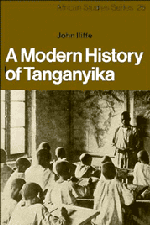Book contents
- Frontmatter
- Contents
- List of maps and tables
- Preface
- Acknowledgments
- Terminology
- Abbreviations
- Map I Tanganyika
- 1 Intentions
- 2 Tanganyika in 1800
- 3 The nineteenth century
- 4 The German conquest
- 5 Colonial economy and ecological crisis, 1890–1914
- 6 The Maji Maji rebellion, 1905–7
- 7 Religious and cultural change before 1914
- 8 Fortunes of war
- 9 The origins of rural capitalism
- 10 The creation of tribes
- 11 The crisis of colonial society, 1929–45
- 12 Townsmen and workers
- 13 The African Association, 1929–48
- 14 The new colonialism
- 15 The new politics, 1945–55
- 16 The nationalist victory, 1955–61
- Bibliography
- Index
9 - The origins of rural capitalism
Published online by Cambridge University Press: 03 May 2011
- Frontmatter
- Contents
- List of maps and tables
- Preface
- Acknowledgments
- Terminology
- Abbreviations
- Map I Tanganyika
- 1 Intentions
- 2 Tanganyika in 1800
- 3 The nineteenth century
- 4 The German conquest
- 5 Colonial economy and ecological crisis, 1890–1914
- 6 The Maji Maji rebellion, 1905–7
- 7 Religious and cultural change before 1914
- 8 Fortunes of war
- 9 The origins of rural capitalism
- 10 The creation of tribes
- 11 The crisis of colonial society, 1929–45
- 12 Townsmen and workers
- 13 The African Association, 1929–48
- 14 The new colonialism
- 15 The new politics, 1945–55
- 16 The nationalist victory, 1955–61
- Bibliography
- Index
Summary
Two connected processes dominated Tanganyika's economic history between the wars. One was the continuing integration of local economies into the international economy, until capitalist relationships among Africans appeared and peasant societies emerged in certain areas. The other process was regional differentiation.
It was a peculiarity of sub-Saharan Africa that capitalism and peasant societies evolved together. Peasants live in small communities, cultivate land they own or control, rely chiefly on family labour, and produce their own subsistence while also supplying larger economic systems which include non-peasants. Characteristically, peasants belong to states which exploit them, and they practise a rustic variant of their rulers' high culture. Simultaneous involvement in local community and wider state distinguishes peasants both from tribesmen, whose societies are more exclusively local, and from farmers, who employ non-family labour and are chiefly concerned with the wider market. A peasant society is a society most of whose members are peasants. By this definition the coastal peoples were probably Tanganyika's only peasants before European invasion, although they retained much political autonomy. European control, taxation, acceptance of world religions, and production for the market began to extend peasant status in German times, but it was in the 1920s that peasant societies appeared inland, notably in Kilimanjaro and Buhaya. These two societies differed, because – as is the nature of peasant societies – each contained non-peasants who gave it a distinctive shape: African farmers in Kilimanjaro, African landlords and traders in Buhaya. Yet their similarities were more striking.
- Type
- Chapter
- Information
- A Modern History of Tanganyika , pp. 273 - 317Publisher: Cambridge University PressPrint publication year: 1979



